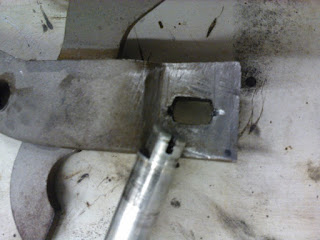In between all the grinding and priming sometimes you want to feel like getting something finished. In addition to that, I'll soon be ready to install the steering column (once it has been reconditioned) and that can only be done after the pedal assembly has been installed. The bushings on the assembly looked quite tired so I ordered a Master Rebuild Kit from a local dealer. As order for a new brake light switch was set as well because the old one had been there during the sandblasting and I did not bother to check whether it was working or not.
 |
| Pedal assembly |
The disassemble is quite straight forward except for the heavy clutch spring. I did not do it like this but later figured out that the easiest way is to push the clutch pedal forward, then to remove the stopper and move the pedal back and the spring is loosened and easy to remove. I did the removal by pulling the axle outwards until the clutch pedal could be moved so much forward that the spring got loose.
 |
| Remove the clutch pedal stopper to ease the removal of the spring |
The clutch pedal is attached to the axle with punched locking wedge that has to be ground or, like in my case drilled off before the axle can be detached.
 |
| The wedge in the axle ties the axle to the pedal |
 |
| The axle drilled and punched off the pedal |
While waiting for the repair kit the parts were cleaned and painted. Maybe too early for the assembly itself as the kit has roller bearings instead of bushings and the bushing housings need to be cut off.
 |
| Bushing housings cut off |
The Scott Drake kit comes with roller bearings and wavy washers which are to be installed from the inside and large washers from the outside. Then the axle may be pressed in to ensure correct line. The bearing housing is secured with O-ring clips. I decided to opt to weld the large washers to the assembly. Then the new axle was welded on the clutch pedal. I did not pay too much attention to the remaining distance from the pedal to the groove on the other end of the axle and had to pay extra time fitting the axle locking washer and pin to the other end. Note what happened with the first washer when the pin was pressed in. So it is important to check that the washer and the pin will fit before welding the axle to the clutch pedal.
 |
| Test fitting |
 |
| Secured with the clip. The pin hole too close to the bearing. |
 |
| Large washer welded and the assembly repainted |
 |
| Brake pedal with new bushings |
 |
| New axle welded in the clutch pedal |
 |
| Axle passing brake pedal |
 |
| First washer got hurt |
 |
| The second one succeeded better |
 |
| The plastic insulator of the clutch spring |
 |
| The easier way to install the spring. |
 |
| Clutch stopper back in |
 |
| Brake light switches, bushings and the shaft |
 |
| The first bushing ring |
 |
| 'Then the shaft, switch and the second bushing |
 |
| The third bushing and the pin |
 |
| Clutch rod with the new brass bushings. Old nylon on the left |
 |
| The hole on the pedal was enlarged to 13 mm. |
 |
| The pad had to be replaced. |
 |
| The final result |
 |
| Ready to be installed |
I like the new feel of the pedals. They feel snug but still easy to operate. In this application the bearings only apply for the clutch operation while the brake pedal goes with bushings and grease. For automatic transmission I would drill a hole through the brake pedal axle housing and the axle and secure them together with a screw to take full benefit of the bearings. This job was well worth the cost and effort while I was at it anyhow.
I also like the color I chose to make it easier to see things when working under the dash. I think the concours correct color is typical Ford's no-color-at-all or 'natural finish' .
No comments:
Post a Comment